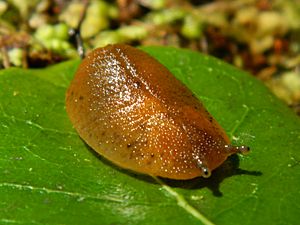Athoracophorus bitentaculatus facts for kids
Quick facts for kids Athoracophorus bitentaculatus |
|
|---|---|
 |
|
| Leaf-veined native slug at Ship Creek near Haast | |
| Scientific classification | |
| Kingdom: | |
| Phylum: | |
| Class: | |
| (unranked): |
clade Heterobranchia
clade Euthyneura clade Panpulmonata clade Eupulmonata clade Stylommatophora clade Elasmognatha |
| Superfamily: |
Athoracophoroidea
|
| Family: |
Athoracophoridae
|
| Genus: |
Athoracophorus
|
| Species: |
A. bitentaculatus
|
| Binomial name | |
| Athoracophorus bitentaculatus (Quoy & Gaimard, 1832)
|
|
| Synonyms | |
|
Limax bitentaculatus Quoy & Gaimard, 1832 |
|
Athoracophorus bitentaculatus is a special kind of slug that lives on land. It's a small, soft-bodied mollusc that belongs to a group of animals called gastropods. These slugs are unique because they are found only in New Zealand.
Contents
What is a Slug?
A slug is a mollusc that looks a lot like a snail, but it doesn't have a shell. Slugs are known for their soft, slimy bodies. They move around by gliding on a muscular "foot." This foot produces a layer of mucus, which helps them slide smoothly.
Why are Slugs Slimy?
The slime that slugs produce is very important for them. It helps them move easily over rough surfaces. It also protects their soft bodies from drying out. This slime can also help them stick to surfaces, even upside down!
What do Slugs Eat?
Most slugs are herbivores, meaning they eat plants. They often munch on leaves, fungi, and decaying plant matter. Some slugs can also be carnivores or omnivores, eating other small creatures or a mix of plants and animals.
Where Does A. bitentaculatus Live?
A. bitentaculatus is found only in New Zealand. This means it is an endemic species. You won't find this specific slug naturally anywhere else in the world. It lives in damp, cool places, often hidden under logs or leaves.
Why are Endemic Species Important?
Endemic species like A. bitentaculatus are very special. They show the unique nature of a country's biodiversity. Protecting these species helps keep the natural balance of their specific ecosystems.

